Get Your ALL ACCESS Shop Pass here →
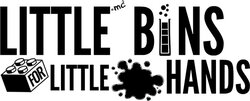

Bread Mold Experiment
Ever ended up with a loaf of moldy bread at home? It’s not something you want to eat! Instead, grow mold on bread for science, and investigate how moisture, temperature, and air affect mold growth. A fun and easy way to observe the mold life cycle for a hands-on biology experiment for kids .
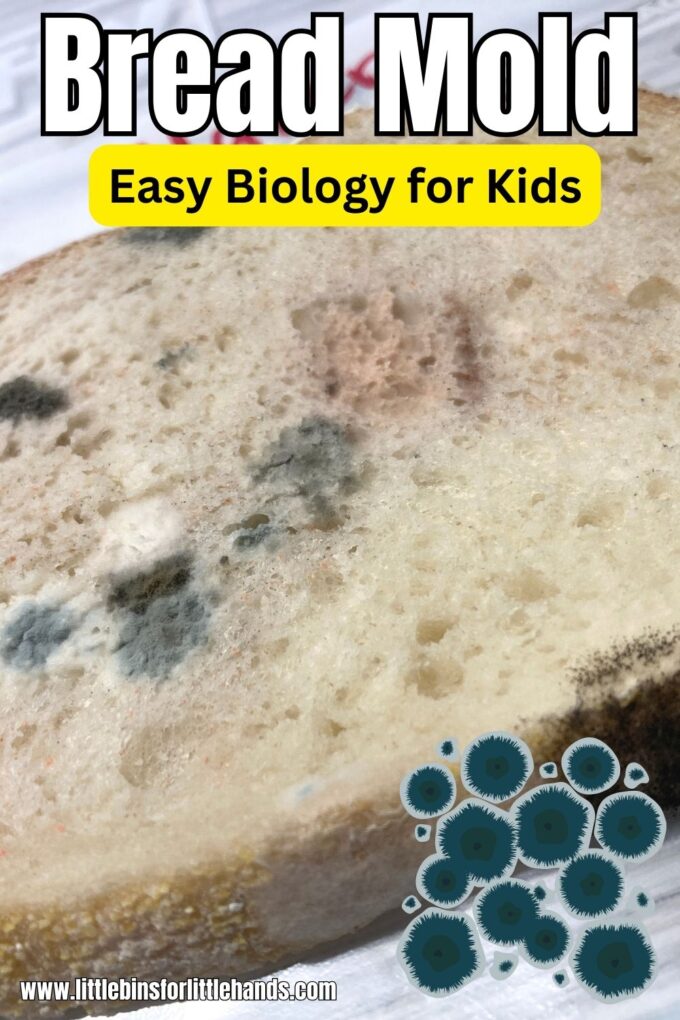
Bread Mold Experiment Variations
Extend the learning by varying your experiment:
Remember only to change one variable for each experiment!
- Add the same amount of water to different types of bread.
- Place the same type of bread in light or dark conditions.
- Use the same type of bread and vary the amount of water on each.
- Place the same type of bread in a warm area and one in a cold area. Use a thermometer to work out the temperature.
- Place the same type of bread in a bag and one directly exposed to air.

Why not use extra slices of bread and set up this germ science experiment !
- 2 slices of bread
Instructions:
STEP 1: Label the plastic bags to identify each slice.
TIP: Don’t forget to make one or two predictions before you start. What do you think will happen to each slice?
STEP 2: Add 10 drops of water to one slice and seal.
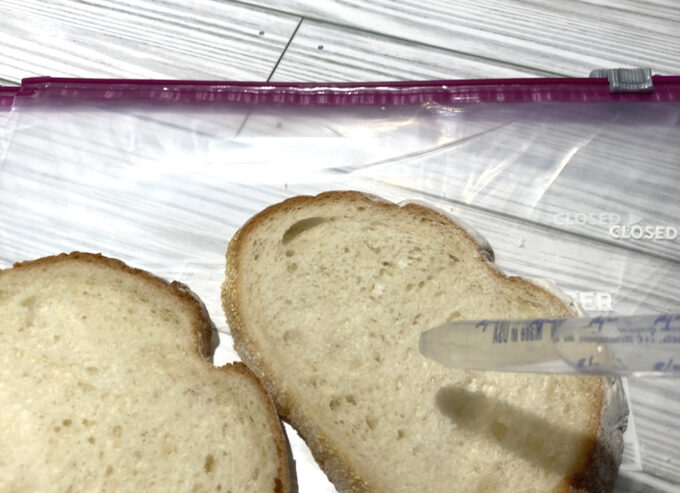
STEP 3: Now add a dry piece of bread to the second bag.
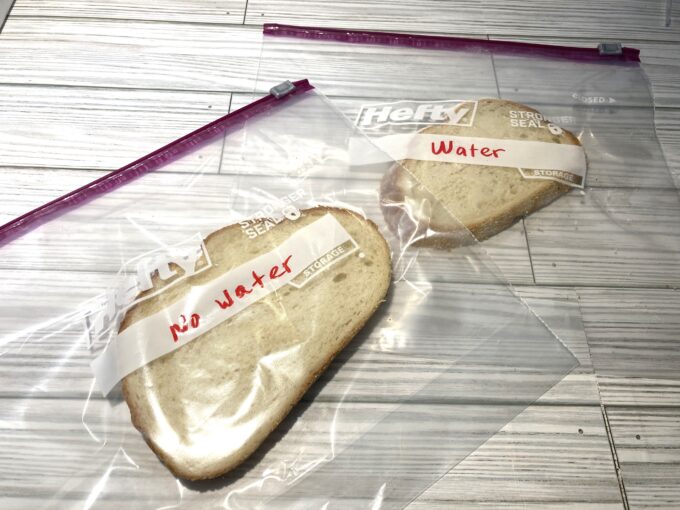
STEP 4: Place the slices in a warm, dark place if possible. Observe and record.
Tip: Make observations every 2nd day over the course of 2 weeks depending on how fast the mold is growing.
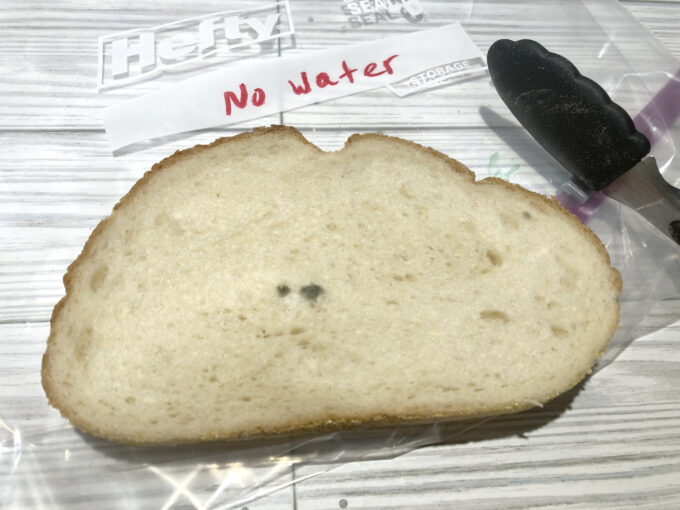
Which piece of bread had the most mold on it? Make sure to read the science of mold to find out why.
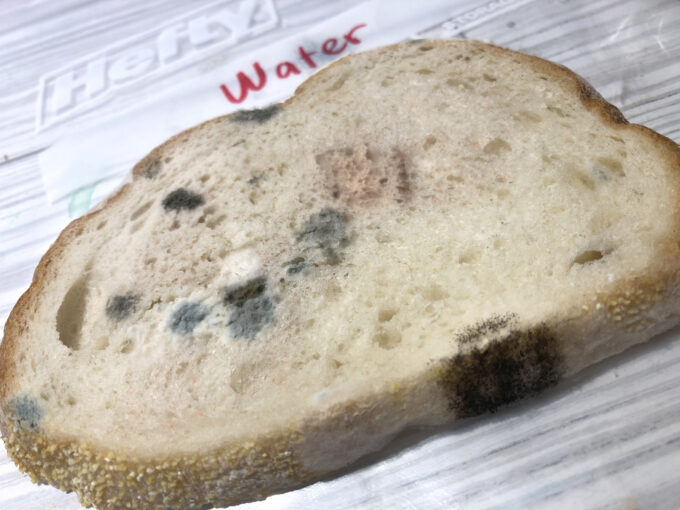
The Science of Mold
Explores the fascinating world of fungi, like Rhizopus stolonifer, that often grow on bread with simple bread mold experiments. These tiny organisms love damp places so bread, with its moisture, is like a paradise.
Mold spores, everywhere in the air, land on the bread. When it’s warm, and there’s enough air and moisture, these spores grow into visible mold.
They grow quickly using special substances that break down the bread’s sugars. The fuzzy stuff you see on moldy bread is made of tiny threads called hyphae, which join together to form a network called mycelium. This helps the mold take in food from the bread.
Understanding bread mold helps us to see how fungi grows and shows how important conditions like warmth, air, and moisture are for these microorganisms to spread.
Turn It Into A Bread Mold Science Fair Project
Science projects are an excellent tool for older kiddos to show what they know about science! Plus, they can be used in all sorts of environments including classrooms, homeschool, and groups.
Kids can take everything they have learned about using the scientific method , stating a hypothesis, choosing variables , making observations and analyzing and presenting data.
Want to turn this experiment into an awesome science fair project? Check out these helpful resources.
- Science Project Tips From A Teacher
- Science Fair Board Ideas
- Easy Science Fair Projects
Free Printable Science Journal Worksheets
Create a science notebook with these easy-to-use science worksheets to accompany any experiment. Grab your free science process journal pack !

More Fun Biology Science Experiments To Try
- Investigate seed germination with a seed jar .
- Set up a mini-greenhouse .
- Make a model of your heart or of your lungs .
- Learn with animal cell and plant cell coloring sheets .
- Try this easy strawberry DNA lab.
- Set up a germ experiment.
- Explore the life cycles of various animals and plants .
- Candy DNA and coloring sheet.

Helpful Science Resources
Here are a few resources that will help you introduce science more effectively to your kiddos or students. Then you can feel confident yourself when presenting materials. You’ll find helpful free printables throughout.
- Best Science Practices (as it relates to the scientific method)
- Science Vocabulary
- 8 Science Books for Kids
- All About Scientists
- Science Supplies List
- Science Tools for Kids
- Join us in the Club
Printable Science Projects For Kids
If you’re looking to grab all of our printable science projects in one convenient place plus exclusive worksheets and bonuses like a STEAM Project pack, our Science Project Pack is what you need! Over 300+ Pages!
- 90+ classic science activities with journal pages, supply lists, set up and process, and science information. NEW! Activity-specific observation pages!
- Best science practices posters and our original science method process folders for extra alternatives!
- Be a Collector activities pack introduces kids to the world of making collections through the eyes of a scientist. What will they collect first?
- Know the Words Science vocabulary pack includes flashcards, crosswords, and word searches that illuminate keywords in the experiments!
- My science journal writing prompts explore what it means to be a scientist!!
- Bonus STEAM Project Pack: Art meets science with doable projects!
- Bonus Quick Grab Packs for Biology, Earth Science, Chemistry, and Physics

Subscribe to receive a free 5-Day STEM Challenge Guide
~ projects to try now ~.
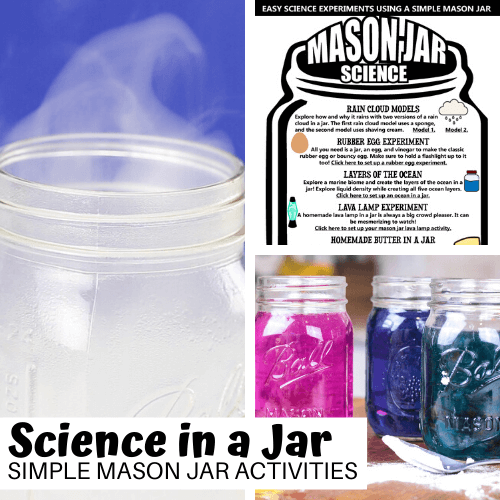

- Foundations
- Write Paper
Search form
- Experiments
- Anthropology
- Self-Esteem
- Social Anxiety

- Kids' Science Projects >
Mold Bread Experiment
What makes mold grow.
We are going to perform a mold bread experiment to grow our own mold and find out whether mold does indeed grow faster at higher temperatures.
This article is a part of the guide:
- Kids' Science Projects
- Paper Towel
- Salt Water Egg
- Fruit Battery
Browse Full Outline
- 1 Kids' Science Projects
- 2 How to Conduct Science Experiments
- 3.1 Mold Bread
- 3.2 Popcorn
- 3.3 Salt Water Egg
- 3.4 Corrosiveness of Soda
- 3.5 Egg in a Bottle
- 3.6 Fruit Battery
- 4.1 Pendulum
- 4.2 Paper Towel
- 4.3 Paper Airplane
- 4.4 Charge a Light Bulb
- 4.5 Lifting Ice Cube
- 4.6 Magic Egg
- 4.7 Magic Jumping Coin
- 4.8 Invisible Ink
- 4.9 Making-a-Rainbow
- 4.10 Oil Spill
- 4.11 Balloon Rocket Car
- 4.12 Build an Electromagnet
- 4.13 Create a Heat Detector
- 4.14 Creating a Volcano
- 4.15 Home-Made Glue
- 4.16 Home-Made Stethoscope
- 4.17 Magic Balloon
- 4.18 Make a Matchbox Guitar
- 4.19 Make Your Own Slime
- 5.1 Heron’s Aeolipile
- 5.2 Make an Archimedes Screw
- 5.3 Build an Astrolabe
- 5.4 Archimedes Displacement
- 5.5 Make Heron’s Fountain
- 5.6 Create a Sundial

In ten days you will be able to answer this important question and make a contribution to science!
But what is mold? What makes it grow?

What is Mold?
Mold is something that we often take for granted, as something that makes us have to throw the bread away or the cheese smell bad.
Mold is, in fact, a fascinating organism which has had many different uses over the years and our lives would not be the same without it.
Most of us know that food seems to become moldy more quickly in the summer than in the winter when it is colder. Food in refrigerators seems to keep longer than food left out in the sun. Is this true? Does temperature really affect the rate at which mold grows?
Important Note
Please note that some people are allergic to mold; ask your doctor or parents. If this is the case, do not pick the Mold Bread Experiment. Always wear gloves and a mask, wash your hands, and don’t eat or drink whilst you are performing this study.

Performing the Mold Bread Experiment
In the Mold Bread Experiment we are trying to prove that;
"Mold grows quicker at higher temperatures."( Hypothesis )
What You Need for the Mold Bread Experiment
- 15 slices of bread. Any sort will do but it is perfectly fine to use cheap white sliced bread as then you will know that all of the slices are a similar size, weight and thickness. You must make a note of the brand and use-by date so that anybody else wanting to repeat the Mold Bread Experiment can use the same type.
- 15 sealable sandwich bags
- 1 piece of film or clear plastic with a 10x10cm grid drawn onto it
- Clean knife
- Chopping board
- Sticky labels
- Mold Spores - if you can’t get these from your school don’t worry. There are mold spores all around us in the air which will eventually grow on the bread but your experiment will take longer.
- Using the sticky labels and the marker pen label the bags. Mark 5 bags as ‘A’, 5 as ‘B’ and 5 as ‘C’. You also need to label each set of bags 1 to 5.
- Cut the bread into 10 x 10 squares using the chopping board and knife.
- Inoculate the bread thoroughly with the mold solution. Try to coat each slice with a similar amount of the culture although this can be difficult.
- Put one slice of this bread into each bag and seal the bags tightly.
- Put the 5 ‘A’ bags into the freezer, the 5 ‘B’ bags into the refrigerator and the 5 ‘C’ bags somewhere safe in a warm room. Because the bags in the freezer and fridge will not be getting much light it is best to cover the ‘C’ bags to make sure that light is a constant.
- Every 24 hours, preferably at exactly the same time every day, using the plastic grid, count the number of square centimeters of mold on each slice of bread. If the mold covers more than half a square, count it as 1cm, if less than half a square, count as 0 cm. You must never open the bags.
- You should repeat these counting processes for 10 days or until there are significant measurable results .
- Keep a careful note of your results for each slice of bread for the entire duration of the experiment. You can even take pictures or draw the slices if you want to be really scientific!
- Average the results for sample types A, B and C.
- Once you have finished, throw out all of the bags without opening them.
Because each square of bread is 100 cm2, you can express your results as a percentage. For each of the bread types, A, B or C average the amount of mold grown over the ten days and write these figures into a table.
You can then plot this information onto a graph and begin to explore your results. You can plot the amount of mold on each bread sample and compare it to the number of days, like in the diagram below. This can be done with a sheet of graph paper and colored pens or on a computer.
Is the Graph Correct?

Could you replicate the graph below or is your graph different? We have done this, but will not give you our answer, so you can test for yourself!
Why are the Results Important?
The food industry spends millions of dollars every year on refrigeration and it is very important that they know what temperature they need to stop mold from growing. Moldy food must be thrown away and this costs restaurants and manufacturers a lot of money.
For companies using mold to make food or medicine they need to know at which temperature mold grows best. The faster the mold grows, the quicker they can sell their product and make money.
Further Experiments
Now that you have finished and obtained some results, maybe you want to see if other variables affect the rate at which mold grows. Maybe you could keep the temperature the same for all of the samples but use different types of bread.
You could try adding moisture to the slices or putting different amounts of sugar or lemon juice onto the slices. As long as you only vary one thing at a time, you can make some interesting studies about mold.
Temperature is not the only thing that affects the rate of mold growth so feel free to try and find out more about this interesting organism.
Facts About Mold
- Mold is not a plant but a fungus like mushrooms and toadstools. It grows on food and other organic matter, breaking it down into slime and extracting nutrients for growth.
- Alexander Fleming discovered that a common type of mold fungi kills germs. From this, he made a medicine called penicillin which has saved millions of lives over the last 80 years. Many other life-saving drugs are made from chemicals obtained from mold.
- Mold is one of nature’s cleaners. It breaks down dead organic material and recycles the nutrients back into the soil. It is essential in nearly every ecosystem in the world.
- We use molds for flavor in some foods such as blue cheese, soy sauce and Quorn (TM) .
- Psychology 101
- Flags and Countries
- Capitals and Countries
Martyn Shuttleworth (Nov 24, 2008). Mold Bread Experiment. Retrieved Dec 10, 2024 from Explorable.com: https://explorable.com/mold-bread-experiment
You Are Allowed To Copy The Text
The text in this article is licensed under the Creative Commons-License Attribution 4.0 International (CC BY 4.0) .
This means you're free to copy, share and adapt any parts (or all) of the text in the article, as long as you give appropriate credit and provide a link/reference to this page.
That is it. You don't need our permission to copy the article; just include a link/reference back to this page. You can use it freely (with some kind of link), and we're also okay with people reprinting in publications like books, blogs, newsletters, course-material, papers, wikipedia and presentations (with clear attribution).
Related articles
Paper Towel Experiment
Paper Airplane Experiment
Pendulum Experiment
Experiments with Popcorn
Want to stay up to date? Follow us!
Get all these articles in 1 guide.
Want the full version to study at home, take to school or just scribble on?
Whether you are an academic novice, or you simply want to brush up your skills, this book will take your academic writing skills to the next level.

Download electronic versions: - Epub for mobiles and tablets - For Kindle here - PDF version here
Save this course for later
Don't have time for it all now? No problem, save it as a course and come back to it later.
Footer bottom
- Privacy Policy

- Subscribe to our RSS Feed
- Like us on Facebook
- Follow us on Twitter
Science Project Ideas

Bread Mold Experiment
This biology experiment requires you to gather some background information before starting with the research. Once you know what the organisms called molds are, understanding the activity would be easy.


How to Do Mold Bread Experiment
A piece of bread kept under moisture and high temperature develops mold on its surface.
Materials Needed
- Slice of bread
- Plastic zipper bag
- Masking tape
- Camera (optional)
- Sprinkle water on the slice of bread.
- Put the bread in the plastic bag and zip it.
- Use the tape to secure it further.
- Write today’s date on the tape with the marker.
- Leave the bag undisturbed for 7 days in a warm place outside the house.
- Track the growth of the mold by checking the sample every day. Collect data in the notebook on the size and color of the colony. You can also take a photograph of the bread each day.
- In the end, throw away the bag with the moldy bread without consumption or inhalation near it.
You Can Also Try Out
- Instead of just 1 slice, take 3 slices of bread and mark them as A, B and C with the marker on the masking tape. Repeat the process by placing one in the refrigerator, one in a dark room and the last one in a sunny place. Observe and analyze the rate of mold growth under the different conditions of temperature and light.
- Check the results by keeping one of the variables like temperature constant for the 3 samples mentioned above but altering the type of bread in the different samples.
- Instead of adding moisture to the 3 slices as indicated in the steps above add different amounts of lemon juice or sugar to the slices. How does that affect the molding on the bread? What happens if you add salt?
For accurate measurements, you can take the help of a plastic grid to check how many squares or cm of it gets covered by the mold. While creating the lab report for your science experiment you can plot that data along the Y-axis and the no. of days along the X-axis on a graph paper.
Mold on Bread Project Video
What is happening a conclusion.
Mold is a fungus that best grows in dark, moist and warm conditions. It feeds on organic matter like bread while decomposing the same. Hence it is harmful to consume the moldy bread or even inhale the smell as mold spores could enter the body in that way. Adding salt inhibits the development whereas sugar enhances the method. Types of bread with high moisture content like rye, oat, Boston and other dark breads mold faster than the drier and denser varieties.
Some Interesting Facts
Many food industries depend on molds to produce food materials like soy sauce, country cured ham, certain types of cheese, etc. They need to know the favorable conditions for fast culture. On the other hand, there are other food industries that take measures to preserve the produce from molds. They utilize the knowledge of the unfavorable situations of infestation.
If you are planning to demonstrate molds growing on bread at a science fair, it is best to perform the experiment beforehand and exhibit the resulting samples for all to see with due explanation of the method adopted.
Leave a Reply Cancel reply
Your email address will not be published. Required fields are marked *
Save my name, email, and website in this browser for the next time I comment.
- Skip to primary navigation
- Skip to main content
- Skip to footer
Science Struck
A Simple Experiment to Grow and Study Bread Mold
Bread mold experiment is a fun science project, where one can observe the growth of a live organism on household bread! Here is a detailed guide that will help you in conducting this experiment.
Like it? Share it!

Many people tend to find mold growing on bread disgusting. But, did you know that mold is also one of nature’s cleansers , that breaks down dead organic materials and recycles these nutrients back to the soil, which makes it essential for the ecosystem?
Mold is a type of fungi, which grows on any plant or animal material. Mushrooms and toadstools are a type of fungi. Mold grows on food and other organic matter, and thus, breaks it down into slime by which it extracts nutrient for its growth. This is many times studied in school with a simple experiment.
Bread Mold Project
To study the growth of mold on bread samples every alternate day, for a course of 2 weeks.
If you are allergic to mold, then avoid performing this experiment or use mask and gloves for safety. Seek permission from your parents and teacher before you start with the experiment. Also, after you are done noting down the results of the experiment, dispose off the bags containing moldy bread safely, without opening them.
Here is a list of materials you will need to perform the experiment.
- 5 slices of bread
- 5 transparent sealable bags
- Sticky labels
- Magnifying glass
- 5 – 7 cotton swabs
- A tablespoon
- Lemon juice/water/apple juice/salt/sugar (at least two of these items are required)
Growing mold can be a simple experiment, and performed on a slice of bread. However, to make it interesting and more detailed you can work on 5 samples of breads rather than just one. So, gather the above equipment and follow the below steps.
- Take the cotton swabs and run them over areas which have dust, like under a table, bed, or basement.
- Then rub the dust from cotton swab over the first bread slice.
- Repeat steps 2 for the other four bread slices.
- Seal three bread slices inside three transparent sealable bags.
- Put sticker on the three bags, and write down using a marker on them.
- On the first sticker write “Sample #1 – Dark Closet”; on second write “Sample #2 – Refrigerator”, and on the third write “Sample #3 – Under Light”.
- So, keep the first sample in a dark closet, second in a corner of the refrigerator where it doesn’t gets disturbed, and the third one in an area of the house which is most of the time brightly lit.
- Now, take the remaining two samples. Before you seal them in the bags and mark them with sticker add one of the above mentioned five items to them. For example, on the fourth bread sample you can add some salt, while on the fifth you can add 2 tablespoons of water. Keep these two sample in a place where they don’t get disturbed.
Observations
Wear mask and gloves whenever observing the bread mold samples. Make sure you observe the five bread samples every alternate day at a fixed time of the day, say 2 pm. It is important that you observe them every alternate day without fail, and note down your observations in a table. You can note down their physical appearance like color, shape, amount of growth per day, texture, etc. Another column of your table can be observations of the mold under the magnifying glass. If you want, you can take videos or pictures of the mold every alternate day. This will help in concluding your experiment.
If you are performing this experiment at home, then you might not have access to a microscope. However, when this experiment is performed in school many times the students are asked to observe the mold under a microscope. Note down, the appearance of the mold under the microscope, this can form a part of the observation. Usually, one sees thread like structures on top of which there is a circular shape. Here is a diagram of bread mold in detail.

You will observe different conclusions for different samples. The mold which was kept in a warm, dark, and moist condition will grow the best. However, the sample that was in the refrigerator will have a slower growth. Also, substances like salt tend to slow down the growth of bread mold. Conclusion is an important part of the experiment, so make sure you read your observations carefully before you put down the appropriate conclusion of the project. Here are pictures of mold growth on different types of breads.

Further Experimentation
Once you have tried out this experiment, you can try out further experiments using different materials. You can try growing mold on different types of breads, while maintaining the same temperature. You could also try adding more moisture to the slices of the bread, or use different amounts of lemon juice and sugar on the slices. This way you can vary one element, and note down various observations of the mold growth. So, select a hypothesis and using the appropriate materials perform the experiment again. You can also consider growing mold on soft fruits. Here are pictures of mold growing on a lemon, few strawberries, and a tangerine.

Interesting Mold Facts
The above experiment will help to study bread mold in detail. Here are some fun facts about mold that will add to your knowledge.
Mold is used by various companies to make food and medicine.
Did you know that mold is added to flavor certain cheeses? You can observe blue-gray veins on a piece of blue cheese, which appear due to the mold added to it.

Lichens are formed due to an awesome partnership between fungi and algae.

There are over 10,000 species of mold!
Did you know that outdoors, mold is almost everywhere?
To prevent mold from growing on foodstuffs, the food industry spends a lot of money on refrigeration.
I hop you enjoyed reading the above facts on mold. So, gather the equipment necessary for the experiment, perform the experiment, note down the observations every alternate day, and draw the appropriate conclusion. Good luck!
Get Updates Right to Your Inbox
Privacy overview.
How to Experiment With Bread Making, Yeast, and Gluten

Introduction: How to Experiment With Bread Making, Yeast, and Gluten

With DoughLab (or the equivalent components from the store), you can design your own delicious bread experiments and learn about yeast! Before you start, here's the skinny on saccharomyces:
Yeast , a single-celled fungus that belongs to the same kingdom as mushrooms, is one of the most common microbes in the world. In the presence of oxygen, this fungus munches up sugars and produces carbon dioxide, or CO2, making bubbles in liquid or dough. (No wonder yeast means "bubbles" in old English and was dubbed saccharomyces, or “sugar fungus” in Latin!) This process of eating food and releasing waste is called “respiration.” Interestingly, even without oxygen, yeast continue to respire. However, instead of producing CO2, yeast will produce alcohols through a process called fermentation, making yeast a key player in beer and wine production.
Step 1: The Art of Experimentation
To design your own bread experiments, use the “Scientific Method":
The Scientific Method
- Purpose: What do you want to learn about?
- Testable Question: Turn your idea into a question that can be answered through experimentation.
- Independent Variables: Decide on your independent variables, the things you'll modify in your experiment (e.g., flour type, temperature).
- Dependent Variables (Measurables): Determine your dependent variables, the things you'll measure in your experiment (e.g., loaf rise time, bread taste, texture).
- Hypothesis: What do you expect the results of your experiment to be?
- Materials: List all the materials and supplies you'll need.
- Procedure: Write out each step so that someone else could repeat your experiment using your directions.
Analyzing Data
Once you’ve started your experiment, collect and analyze your data:
- Data Collection: Record what happens, especially to your dependent variables. Remember to include units, times of measurements, sketches, and any other observations.
- Data Display: Display your data so that others can easily understand it. Make graphs (line, bar, circle, or scatter) or a time series of sketches.
- Analysis: Examine your data, and describe any patterns, trends, and changes you see.
- Conclusion: Were you able to answer your testable question from your results? What did you find out? Were the results what you expected? Why or why not? Did anything go wrong along the way? Identify anything you'd do differently if you were to do the experiment again. Identify any new ideas or new questions that arise as a result of running this experiment.
Step 2: Prepare Your Experiment

Before you begin, plan your experiment ! Determine which “independent” variables you’d like to change and which “dependent” variables you’d like to measure. How do your independent variables impact your dependent variables?
Independent Variables :
- Sugar level
- Yeast vs. no yeast
- Temperature
- Water content
- Water type (distilled vs. tap)
- Other ingredients (yogurt, baking soda, salt, honey, etc.)
- Can you think of more...?
D ependent Variables:
- Yeast respiration rate (see below)
- Dough expansion, AKA rising
- Dough or bread texture
- Dough pore size, AKA bubble size
- Color, before and after baking
Measuring Respiration Rate
“Respiration” describes the process of munching up food and releasing waste. Watching yeast respire involves putting gloves on top of your dough containers to capture your yeast's waste CO2 and seeing how fast this CO2 inflates the gloves.
Step 3: Sample Experiments
- How does yeast impact dough and bread?
- How does gluten impact dough and bread?
- How does temperature impact yeast’s “respiration” rate?
- What ingredients impact yeast’s respiration rate?
Bonus Experiment: Sourdough (Quick version)
Ever wondered what makes sourdough bread sour? Many types of bacteria, such as lactobacillus, produce lactic acid as a waste product when they eat, which makes bread and yogurt sour. In sourdough, these bacteria typically outnumber yeast 100-to-1! Try adding a bit of yogurt with active cultures to your dough to see if you can grow lactobacillus and make tasty sourdough bread! For the traditional method of making sourdough, skip to Step 10.
Step 4: Assemble Materials

You'll need the following materials, included in Magical Microbes's DoughLab , or available at your local grocery (or pantry!):
- High-gluten flour
- 3 large packets of cane sugar, or a bag of sugar
- 6 small packets of salt, or a box of salt
- Yeast packet
- Measuring spoon (1/4 teaspoon)
- 3 Graduated plastic containers
- 3 Mixing sticks, or spoons
- 3 Latex gloves
- 3 Foil baking pans
Note: You'll also need a pen and scissors.
Step 5: Prepare Dry Ingredients

- Wash your hands. (Save the gloves for your yeast!)
- Optional: Put down newspaper on your workspace.
- Label your three clear containers. In these instructions, container #1 is the “Control,” container #2 has “Added Sugar,” and container #3 has “No Yeast.”
- For all three containers, add flour up to the 200ml mark (7/8 cup for each container).
- Add 3 large packets of sugar (1/4 tablespoons total) to container #2, the “Added Sugar” container.
- Add 2 small packets of salt (3/4 teaspoons total) to each container.
- Open the yeast packet using a pair of scissors. Add 3 small spoonfuls of yeast (3/4 teaspoon total) to container #1 (the “Control”) and Container #2 (the one with “Added Sugar”). Level off each spoonful (1/4 teaspoon) of yeast before adding it to your container. No yeast goes into container #3.
- Mix the dry ingredients together with a mixing stick (or clean spoon). Be sure to use a new stick (or spoon) for each container so that you don’t cross-contaminate the mixtures. Keep your mixing sticks in their corresponding containers. You’ll need them again later.
- Gently knock the jars down on the table a few times to level the mix.
Step 6: Activate the Yeast

- Get a big glass of luke-warm water from the sink. All containers should get the same temperature water.
- Pour the water over the dry ingredients up to the 350ml mark for each container (2/3 cup of water). Pour quickly so you've finished pouring before the water starts to seep into the flour. This ensures the same amount of water is poured into each container.
- Mix until the consistency is smooth. Use the same mixing sticks (or clean spoons) from Step 8 to avoid cross-contamination.
- Work out any flour clumps. If your dough is dry and difficult to mix, add water until all your doughs are the same gooey consistency.
Observation Time: Try pulling up the sticks to test the dough consistency. Why might it be stretchy?
What's Happening?
With the addition of warm water, yeast “activate,” meaning they begin to swim, eat, and multiply. This process starts immediately. Yeast prefer warm conditions which is why warm water is recommended.
The addition of water also allows the straggly glutenin and gliadin proteins to bond together to form gluten. Gluten proteins expand and become tangled up with other straggly gluten proteins nearby. This causes dough to become stretchy and gooey.
Step 7: Knead
- Optional messy-but-fun step: With washed hands, scoop up the dough and knead it (fold it in on itself repeatedly). Wash your hands between each container to prevent contamination.
- After kneading for a few minutes, squish the dough back into the container, and flatten the top.
One of the reasons bakers knead dough is to uncoil gluten compounds and encourage more linkages between them. This strengthens the gluten network and gives bread a more uniform, chewy texture.
Once you let the dough rest, the yeast go to work! They start munching up sugars in a process called “respiration.” When yeast have lots of oxygen around, they perform “aerobic respiration,” releasing carbon dioxide (CO2) as a waste product. In this experiment, the gas fills up the gloves. The happier the yeast, the faster their respiration rate, and the faster the gloves will inflate!
Step 8: Rise

- Stretch the opening of the gloves tight over the tops of the jars so that they just cover the top rim.
- Let the containers rest at room temperature (out of direct sunlight) for 30-45 minutes, or until the dough has reached the top of the container.
Observation Time: Which glove inflated the fastest? Why? Is there is a difference in bubble size or consistency in the different doughs?
Step 9: Bake and Eat!

- Now, get ready to bake by turning the oven to 350 F (adult supervision required). Mark the side and bottom of the foil pans with “1”, “2,” and “3”, by indenting them with your finger or by using a pen.
- Remove the gloves and place each ball of dough into the corresponding tin. Alternatively, shape your own foil packets (caution: your dough might ooze at the seams if you try this, so pinch the corners tight)! For a crispier crust, rub the top of your dough with oil or water.
- Bake the tins together for 20-30 minutes until the top of each loaf is golden-brown (adult supervision required). Let the loaves cool for a few minutes, then enjoy the results of your experiment!
Observations Time: What differences do you observe in your breads? Think about taste, texture, density, color, etc. Can you explain what caused these differences?
Step 10: Bonus: Catch Your Own Yeast! (and Make Sourdough)
For this experiment, you'll want a supply of whole wheat flour.
1. Prepare your Microbe Bait...
- In a clean jar, add flour up to the 200ml mark (3/4 cup + 1 tablespoon).
- Add room temperature water up to the 350ml mark (1/2 cup + 2 tablespoons). If you've got non-chlorinated water, bottled or filtered, use it!
- Mix well with a spoon or mixing stick.
- Place a clean glove over the top of the jar such that it covers the top rim.
- Store your fledgling starter (dough) in a warm place.
...and Wait
Now that you’ve set up your microbe bait, it’s time to wait. Naturally occurring yeast are probably starting to eat and replicate, though it may take time to see any activity.
2. Let your Starter Culture
- After 24 hours, remove half of your dough, and mix in 7 scant tablespoons of flour and 4 tablespoons of water. Put your glove back on the container. If your dough looks good, you can save the dough you removed in an air-tight container in the fridge and bake it later! Not e: Do not eat your mixture raw. Although this is a time-tested method, there's no way to guarantee that good microbes are present and bad ones aren't. Use your eyes, nose, and the help of a microbially responsible adult to decide whether or not to use your mixture for bread.
- Repeat Step 1 daily until your starter is bubbling and yeasty or fruity smelling.
Once you see bubbling in the mixture and the glove inflating, your yeast are replicating! You’ve probably also got some acid-producing bacteria in there that will give you sourdough. If you see weird colors, fuzzy patches, or anything else that looks like mold, you’ve caught some other moldy microbes, and you’ll need to start your sourdough starter over.
3. Maintain your Starter
- Now that your culture is alive and well, continue to remove half and mix 7 scant tablespoons of flour and 4 tablespoons of water into your container every 12 hours . Put your glove back on your container after each addition. Repeat this step until your mixture looks slightly foamy, which can take up to 2 weeks.
- Once your mixture looks foamy, repeat step 1, and if your mixture doubles in volume in about 6 hours, it's time to use. Otherwise, continue repeating step 1 until your mixture doubles in 6 hours.
- Now, repeat step 1 one last time, and once your mixture is doubled in size and actively bubbling (a few hours), take what you need to use in your sourdough recipe of choice, and place the remainder in the fridge.
4. You're ready to bake! Use your starter from step 3.3 with any recipe you please!
Long-term care: Store your starter in the fridge, and feed by mixing in 7 scant tablespoons of flour and 4 tablespoons of water once a week. When you're ready to use your starter, take it out of the fridge, and return to Step 2 , "Activate your Starter."
Step 11: Bonus: the Great Mold Race!
For microbes, some foods are easier to digest than others. Nutrients that are easily digested are called “bioavailable.” Foods that have a lot of “bioavailable” nutrients, like bread and milk, often mold or sour quickly, which is why many store-bought breads contain preservatives and other chemicals to prevent microbes from growing on them.
The following is a simple experiment that will show you which breads have the most “bioavailable” nutrients and the impacts of preservatives:
- In a clean plastic sandwich bag, place one small (2” x 2”) piece of damp paper towel.
- Place a slice of bread in the bag.
- Seal up the bag and let it sit at room temperature out of direct sunlight.
- Repeat steps 1-3 for the different breads you’ve made and/or breads from the store.
- Now, wait...
Check the bags daily to see which pieces of bread are molding. Record what percentage of the bread is covered by mold, and see if the mold coverage follows an exponential growth curve. What differences do you see between the breads? Can you explain the results you find?
Step 12: Bonus: Gluten Isolation (Make Your Own Seitan!)
Wheat flour contains a protein, called gluten, which adds to the stretchiness of dough and the chewiness of bread. The following activity demonstrates how you can isolate gluten from flour to make seitan:
- In a container, mix 250 ml (1 cup + 1 tablespoon) of high-gluten flour with 150ml (1/2 cup + 2 tablespoons) of tap water.
- Knead the dough in your hands until it's a compact ball.
- Cup the dough in your hands, and run cold water over it continuously. The cold water will dissolve the starch in the dough, but it won’t dissolve the gluten.
- Continue rinsing and gently massaging the dough until the water is no longer milky-looking.
You now have a ball of gluten protein! Play with it, and notice that the ball is comprised of tightly-woven clumps of gluten. Try tearing those clumps apart to see how strong gluten strands can be.
After playing with your ball, knead it back together, and pop it in the oven at 450 degrees F for 15-20 minutes (with adult supervision). You’ve created seitan, a food enjoyed all around the world, commonly with soy sauce, ginger, and garlic. Yummm!
Step 13: Taste Tips
Trust the Crust
For serious bakers, crust is often the most important part of bread. If you’re a fan of tough, crunchy crusts, here are some tips:
A) Cut 1/2-inch deep slits into the top of your dough before baking.
B) Rub water or oil over the top of your dough before baking.
C) Use a higher oven temperature (and shorter bake time).
Perfect Pizza Dough
Through your experiments, you’ve learned different ways to make your bread denser or fluffier. Use that knowledge to create your own perfect pizza crust. Or, try:
A) Olive Oil: Smear olive oil onto your baking sheet and over your flattened dough before baking.
B) Salt: Add a couple more pinches of salt to the top of your flattened dough before baking.
When in Doubt, Add Chocolate
There are hundreds of ways to make dessert breads and cakes. We encourage you to experiment with the common additives below to find your own perfect recipe:
A) Vegetable Oil, to make the bread/cake moister
B) Eggs, to add to “fluffiness” and moisture and to help bind ingredients
C) Sweeteners: Sugar, bananas, apple sauce, sweetened chocolate, and even carrots are common ingredients that add sweetness!
Step 14: A Brief History of Bread

About 30,000 years ago, humans began making bread. Early bread was made of a grainy paste and was dense and flat, making it a perfect high-energy food that could be carried and stored. Today, we call these "flat breads," and they include breads from all over the world, like pita, tortillas, and naan.
Roughly 12,000 years ago, people living in modern-day Iraq first domesticated wheat and barley, leading to a massive rise in bread consumption during a period called the "Agricultural Revolution." All over the world, grains, like wheat, barley, rice, and maize started cropping up, due to humans’ careful selection of nature’s biggest and best grains. To grow these grains, people settled down and began to farm and build thriving communities. Populations boomed with these energy-rich, storable foods.
It was only a few thousand years ago that people started using yeast to make bread fluffier and more delicious. Dough was left out in the open to "rise," as yeast (which naturally live on grains and other foods) would munch up sugars and release gas bubbles into the dough. To make this process faster, people would add pieces of old dough, mashed grapes, or beer foam, which are all full of yeast.
Bread has changed quite a bit over the years. Many new ingredients, like vitamin C and anti-microbial preservatives, are now often added to bread to allow bakers to use less-expensive grains and to lengthen shelf-life. Bread started out consisting of only 3 ingredients, grain, salt, and water, but today, bread often contains over 30 ingredients in just one loaf! Bread-making all over the world continues its various traditions, in addition to enjoying new flavors, ingredients, and techniques.

IMAGES
VIDEO